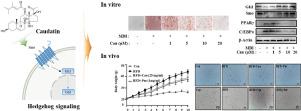Phytomedicine ( IF 7.9 ) Pub Date : 2021-08-19 , DOI: 10.1016/j.phymed.2021.153715 Shuai Qiu 1 , Jae Seok Cho 1 , Jin Tae Kim 1 , Ji Hyun Moon 1 , Yimeng Zhou 1 , Seung Beom Lee 1 , Ho Jin Park 1 , Hong Jin Lee 1

|
Background
The regulative effects of caudatin, a C-21 steroid that is identified from Cynanchum bungee roots, on adipogenesis and obesity have not been studied. Many studies have demonstrated that the activation of hedgehog (Hh) signaling can help prevent obesity. Therefore, we hypothesized that caudatin can inhibit adipogenesis and obesity via activating the Hh signaling pathway.
Methods
To investigate the effects of caudatin on adipogenesis in 3T3-L1 preadipocytes and high-fat diet induced obesity in C57BL/6 mice, in vitro and in vivo experiments were performed. For in vitro evaluation, Oil red O staining were used to represent lipid accumulation in differentiated 3T3-L1 adipocytes. For in vivo assessment, male 5 week-old C57BL/6 mice were fed with standard chow diet, high-fat diet (HFD), HFD with 25 mg/kg caudatin, HFD with 1mg/kg purmorpharmine for 10 weeks, respectively. Hh signaling and key adipogenic marker involved in adipogenesis were evaluated by real-time PCR and western blot. The adipocyte size of white adopose tissue and lipid storage of liver were visualized by hematoxylin and eosin staining. In addition, the expression of Gli1 and peroxisome proliferator-activated receptor γ (PPARγ) in white adipose tissue were investigated by immunohistochemistry staining.
Results
Caudatin suppressed the accumulation of lipid droplets and downregulated the expression of key adipogenic factors, i.e., peroxisome proliferator-activated receptor γ PPARγ and CCAAT-enhancer binding protein α (C/EBPα), through activating Hh signaling in differentiated 3T3-L1 cells. Furthermore, caudatin and the Hh activator purmorpharmine significantly decreased body weight gain and white adipose tissue (WAT) weight in HFD-induced mice and affected adipogenic markers and Hh signaling mediators in WAT, which were in line with the in vitro experimental results.
Conclusion
To our best knowledge, it is the first report to demonstrate that caudatin downregulated adipocyte differentiation and suppressed HFD-induced body weight gain through activating the Hh signaling pathway, suggesting that caudatin can potentially counteract obesity.
中文翻译:

Caudatin 通过激活刺猬信号抑制 3T3-L1 脂肪细胞的脂肪生成并减少高脂饮食喂养小鼠的体重增加
背景
尚未研究 caudatin(一种从 Cynchum 蹦极根中鉴定出的 C-21 类固醇)对脂肪生成和肥胖的调节作用。许多研究表明,刺猬 (Hh) 信号的激活有助于预防肥胖。因此,我们假设 caudatin 可以通过激活 Hh 信号通路来抑制脂肪生成和肥胖。
方法
为了研究尾苷对 C57BL/6 小鼠 3T3-L1 前脂肪细胞和高脂肪饮食诱导肥胖的脂肪生成的影响,进行了体外和体内实验。对于体外评估,油红 O 染色用于表示分化的 3T3-L1 脂肪细胞中的脂质积累。对于体内评估,雄性 5 周龄 C57BL/6 小鼠分别用标准饲料、高脂肪饮食 (HFD)、含 25 mg/kg 尾苷的 HFD、含 1mg/kg 嘌呤吗啉的 HFD 喂养 10 周。通过实时 PCR 和蛋白质印迹评估 Hh 信号传导和参与脂肪生成的关键脂肪生成标记物。通过苏木精和伊红染色观察白色脂肪组织的脂肪细胞大小和肝脏的脂质储存。此外,通过免疫组织化学染色研究了白色脂肪组织中 Gli1 和过氧化物酶体增殖物激活受体 γ (PPARγ) 的表达。
结果
Caudatin 通过激活分化的 3T3-L1 细胞中的 Hh 信号传导抑制脂滴的积累并下调关键脂肪生成因子的表达,即过氧化物酶体增殖物激活受体 γ PPARγ 和 CCAAT 增强子结合蛋白 α (C/EBPα)。此外,尾蛋白和 Hh 激活剂嘌呤吗啉显着降低 HFD 诱导的小鼠体重增加和白色脂肪组织 (WAT) 重量,并影响 WAT 中的脂肪生成标志物和 Hh 信号介质,这与体外实验结果一致。
结论
据我们所知,这是第一份证明 caudatin 通过激活 Hh 信号通路下调脂肪细胞分化并抑制 HFD 诱导的体重增加的报告,表明 caudatin 可能对抗肥胖。



























 京公网安备 11010802027423号
京公网安备 11010802027423号